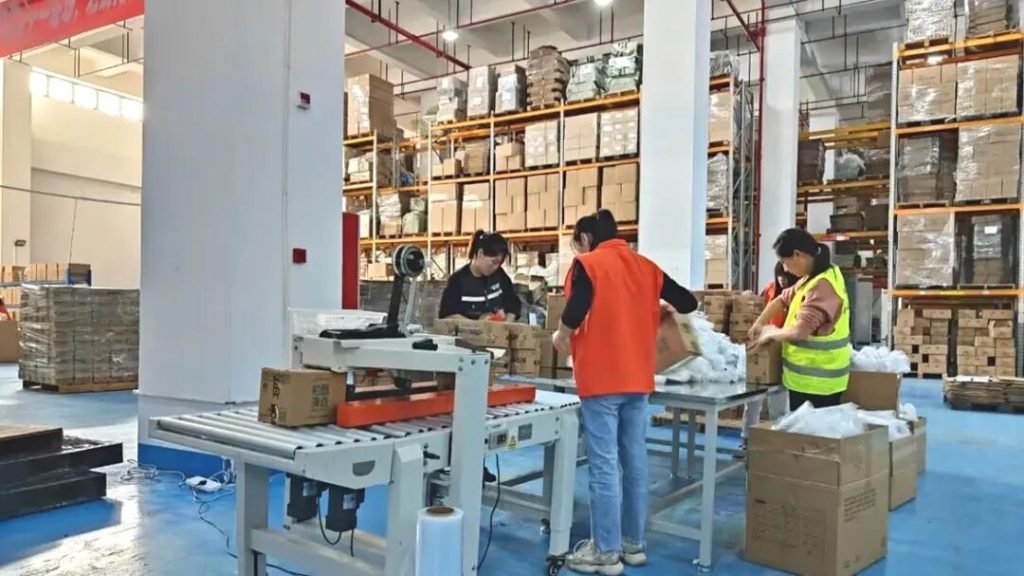
Read More《4块9包邮正在消失,电商不能再压榨快递血汗钱》
Positive Comments: Higher Express Delivery Prices Open a New Channel for the Healthy Development of the E-commerce and Express Delivery Industries
The collective increase in express delivery fees may seem like a “stress test” on the cost side, but in fact, it is a crucial turning point after a decade of deep integration between the e-commerce and express delivery industries. This price increase is not a simple market price fluctuation but an inevitable choice for the industry to break free from the vicious cycle of cut – throat competition and promote high – quality development. Its positive significance is manifested in three aspects:
First, it puts an end to the vicious cycle of “trading price for volume” in the express delivery industry and creates room for service upgrades of express delivery companies. In the past decade, the explosive growth of e – commerce has led to a frenzy of low – price offers such as “free shipping for 3 yuan” and “free shipping for 4.9 yuan”. However, the price of this frenzy has been the “suicidal competition” in the express delivery industry. As reported in the news, the express delivery price in grain – producing areas such as Hebei once dropped as low as “1.2 or 1.3 yuan”, even lower than in traditional low – price areas like Guangdong. Behind these ultra – low – price parcels, express delivery companies have been maintaining their survival by squeezing the profits of terminal outlets, reducing delivery timeliness, and sacrificing service quality. In the long run, this model not only squeezes the income of couriers (the term “hard – earned money” in the industry is quite appropriate), but also traps the entire express delivery industry in a dead – end cycle of “thinner profits, poorer service, and more dissatisfied customers”. After the price increase, the per – parcel revenue of express delivery companies is expected to rise, providing a financial basis for optimizing sorting efficiency, upgrading delivery equipment, and improving the treatment of couriers. For example, if the per – parcel cost increases by 0.5 yuan, the annual profit of leading express delivery companies may increase by billions. These funds can be used for the construction of intelligent sorting systems or subsidies for terminal outlets, ultimately improving the overall service quality.
Second, it forces the e – commerce industry to shift from “low – price cut – throat competition” to “value – based competition” and promotes the reconstruction of the industrial chain value. In the past, the “low – price ranking” mechanism on e – commerce platforms has trapped merchants in a “price war trap”. To gain traffic, merchants have to keep prices as low as possible, and even cut corners by using inferior products or reducing workmanship to lower costs, and then subsidize their profits with the ultra – low express delivery prices (as the news mentioned, “many merchants make money from express delivery”). In this model, although users seem to get low – priced products, they actually receive low – quality goods and unstable services (such as delayed delivery and high parcel loss rates). After the express delivery price increase, this “low – price, low – quality” survival logic is broken. Take a data cable merchant in Guangdong as an example. When the express delivery fee increased from 1.4 yuan to 1.9 yuan, the gross profit per piece directly decreased by 0.5 yuan. This means that if merchants continue to rely on the low – price strategy of “9.9 yuan with free shipping”, they must maintain their profits by increasing the added value of products (such as extending the warranty period or optimizing materials) or reducing other costs (such as optimizing the supply chain). More importantly, when the cost advantage of ultra – low – price merchants disappears, the market will naturally eliminate products that cannot create real value for users, promoting the e – commerce industry to shift from “price competition” to “quality competition”.
Third, it lays the foundation for a “positive cycle” in the entire industrial chain. The relationship between express delivery and e – commerce is essentially a “symbiotic relationship” rather than a “rivalry”. In the past, the low – price strategy of e – commerce has squeezed the profits of express delivery, while the low – quality service of express delivery has damaged the user experience of e – commerce, resulting in a “lose – lose” situation. After the price increase, express delivery companies will have more resources to improve services (such as faster delivery timeliness and more stable terminal outlets), and e – commerce merchants will be forced to optimize product selection and the supply chain (such as reducing low – quality SKUs and improving product cost – performance). Ultimately, users will be able to enjoy a shopping experience of “reasonable price + reliable quality + stable service”. Once this positive cycle is formed, it will drive the entire industry to shift from “scale expansion” to “quality growth”, which is in line with the national strategy of “high – quality development”.
Negative Comments: Short – term Pains Mask the Resistance to Transformation, and the Industry Upgrade Needs to Solve Multiple Contradictions
Although the long – term logic of the express delivery price increase is positive, the contradictions exposed in the short term cannot be ignored. These contradictions may not only delay the industry upgrade process but also trigger local “negative feedback”. The following risks need to be watched out for:
First, the survival pressure of small and medium – sized merchants has intensified, which may lead to the reverse elimination of “bad money driving out good money”. As reported in the news, a towel seller in Hebei dared not raise prices due to the “low – price ranking mechanism” on the platform, and the profit of a data cable merchant in Guangdong was compressed by 0.5 yuan per piece. These cases reflect the dilemma of small and medium – sized merchants: they neither have the scale advantage of large sellers (such as signing lower agreement prices with express delivery companies) nor the brand premium ability. Facing the express delivery price increase, they can only “tough it out”. To survive, some merchants may choose to further reduce the quality of their products (such as using cheaper raw materials), resulting in users receiving products with “unchanged prices but reduced quality”, which will damage the trust of e – commerce platforms. More dangerously, if a large number of small and medium – sized merchants withdraw from the market due to insufficient profits, the supply of certain niche categories (such as white – label daily necessities) may decrease, and large sellers may further raise prices through market monopoly, ultimately at the expense of consumers.
Second, the path dependence on the “free shipping system” hinders price stratification, and the user experience may decline temporarily. Free shipping has become a “standard feature of cut – throat competition” on e – commerce platforms, and users have a very low acceptance of “paying for shipping separately” (as the news compared it to “people can accept expensive food for take – out but are reluctant to pay for the delivery fee”). In this case, if merchants want to pass on the express delivery cost to users, they can only do so through “hidden price increases” (such as canceling shipping insurance or reducing the value of gifts) or “service downgrades” (such as switching to cheaper but less timely express delivery). For example, some merchants may change from “free shipping by SF Express” to “delivery by YTO, STO, ZTO, or BEST”, resulting in the delivery timeliness changing from “next – day delivery” to “3 – 5 days delivery”; or cancel shipping insurance, and users will have to bear the shipping cost when returning products, which will directly affect the shopping experience. More importantly, if the platform adheres to the “low – price ranking” mechanism, even if merchants want to transform through “quality upgrade + appropriate price increase”, they may be forced to give up due to the decline in traffic, making it difficult for “high – quality, high – price” products to gain market recognition.
Third, the implementation effect of anti – cut – throat competition policies is uncertain, and it is difficult to achieve industry coordination. As the news mentioned, “anti – cut – throat competition has become a must – answer question for the industry to break through the dilemma”, but can the unified price increase of express delivery across the country be sustained? Currently, the price adjustment of the express delivery industry still mainly depends on the independent decisions of enterprises. If a company reduces prices again to seize market share, it may trigger a new round of price war. In addition, the express delivery costs vary significantly in different regions (such as the initial prices in Hebei and Guangdong being different). How to balance the price differences between regions and prevent merchants from “relocating to price – low areas” (such as moving from Hebei to provinces with lower express delivery prices) is also a problem that policy – makers need to solve. More importantly, the interests of e – commerce platforms and express delivery companies are not completely aligned: platforms want to maintain low prices to attract users, while express delivery companies want to increase profits. This game may lead to the situation of “policies from above, counter – measures from below” when implementing policies.
Advice for Entrepreneurs: Seize the Transformation Window Period and Shift from “Surviving on Low Prices” to “Creating Value”
Facing the industry transformation brought about by the express delivery price increase, entrepreneurs need to break free from the “cost anxiety” and actively embrace the transformation opportunities. The following three pieces of advice are worth noting:
First, optimize the supply chain efficiency and turn the cost pressure into competitiveness. The express delivery price increase is essentially “squeezing out” the inefficient costs in the industry. Entrepreneurs should take this opportunity to re – sort out the supply chain: on the one hand, reduce the raw material cost by means of centralized procurement and signing long – term agreements with upstream suppliers; on the other hand, optimize the warehousing and logistics links (such as using the cloud – warehouse model to reduce warehousing rent and negotiating tiered pricing with express delivery companies). For example, as reported in the news, some merchants “scrape for profits” by “cutting marketing expenses” and “optimizing the supply chain”. This approach is worth promoting. In addition, using digital tools (such as ERP systems and intelligent product – selection software) to improve operational efficiency can also effectively offset the impact of cost increases.
Second, increase the added value of products and build a “non – price competition” advantage. After the express delivery price increase, users may be less sensitive to “low prices” but will have higher requirements for “cost – performance”. Entrepreneurs should focus on product differentiation: either innovate in function (such as adding a fast – charging function to data cables), or upgrade in service (such as providing “one – year warranty” and “free replacement”), or strengthen the brand (such as conveying the brand story through content marketing). For example, if a towel merchant can emphasize the selling points of “Xinjiang long – staple cotton” and “no fluorescent agents”, even if the price increases from 4.9 yuan to 5.9 yuan, users may still be willing to pay for the recognized quality.
Third, explore the “price stratification” model and actively adapt to market changes. The loosening of the free – shipping system is a long – term trend. Entrepreneurs can try the combination strategy of “low – price basic models + paid value – added services”. For example, for daily necessities in high demand, maintain “9.9 yuan with free shipping” but reduce the packaging cost; for upgraded models (such as “thickened towels” and “fast – charging data cables”), offer options like “14.9 yuan including shipping insurance” or “19.9 yuan with free shipping by SF Express”, allowing users to choose whether to pay for better services. This model can not only meet the needs of price – sensitive users but also provide a premium space for users who pursue quality, avoiding the loss of orders due to a “one – size – fits – all price increase”.
Fourth, pay attention to the changes in platform rules and make early arrangements for new traffic entrances. The “low – price ranking” mechanism of e – commerce platforms may be adjusted due to the industry upgrade (such as increasing the weight of “service scores” and “repurchase rates”). Entrepreneurs should actively study platform rules and make early arrangements for new channels such as content e – commerce (such as short – video product promotion) and private – domain traffic (such as WeChat group operation) to reduce their dependence on “low – price traffic”. For example, by showing the product production process (such as the weaving process of towels) through Douyin short – videos, entrepreneurs can not only build user trust but also attract high – net – worth customers, reducing their dependence on the “low – price ranking”.
The express delivery price increase is not the end but the starting point for the e – commerce and express delivery industries to “eliminate bubbles and strengthen the core”. For entrepreneurs, the short – term cost pressure is both a challenge and an opportunity to force self – upgrade. Only by breaking free from the comfort zone of “surviving on low prices” and shifting to the new track of “creating value” can they stand firm in the industry transformation and become future winners.
- Startup Commentary”Building LLMs: The Knowledge Graph Foundation Every AI Project Needs”
- Startup Commentary”The 17th Year of Tmall Double 11 and the New Map Rewritten by AI”
- Startup Commentary”How to Prepare Your Data for Artificial Intelligence”
- Startup Commentary”Small and Medium-sized Banks: “Cutting the Tail” in Loan Assistance”
- Startup Commentary”The Six AI Giants on Stage: AGI Is No Longer a “Future” Thing”



